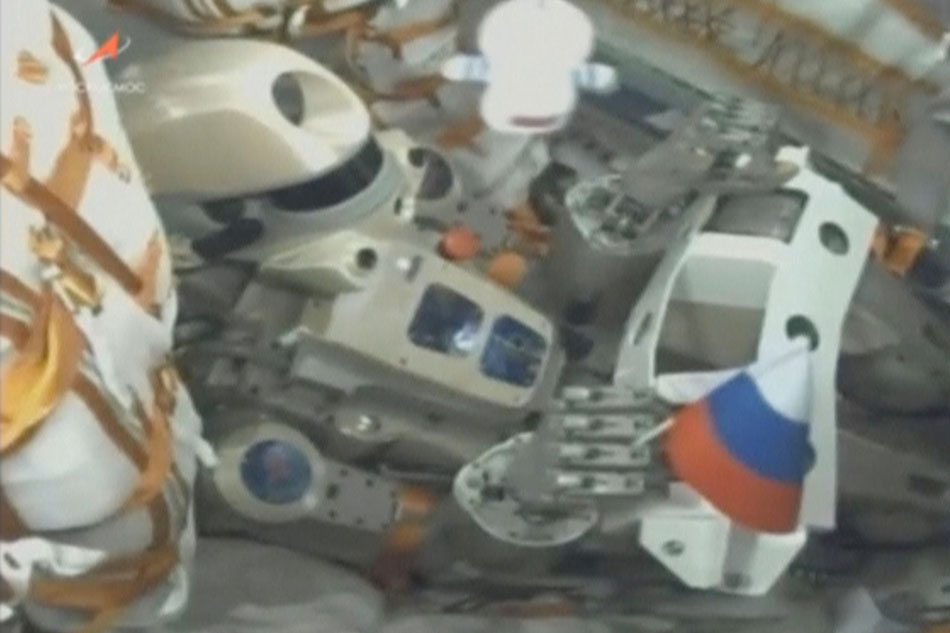Docking fails for Russia's first humanoid robot sent into space
ADVERTISEMENT

Welcome, Kapamilya! We use cookies to improve your browsing experience. Continuing to use this site means you agree to our use of cookies. Tell me more!
Docking fails for Russia's first humanoid robot sent into space
Maria Panina,
Agence France-Presse
Published Aug 24, 2019 06:10 PM PHT
MOSCOW - An unmanned spacecraft carrying Russia's first humanoid robot to be sent into orbit failed to dock automatically at the International Space Station (ISS) on Saturday, in a new setback for Moscow.
MOSCOW - An unmanned spacecraft carrying Russia's first humanoid robot to be sent into orbit failed to dock automatically at the International Space Station (ISS) on Saturday, in a new setback for Moscow.
The Soyuz craft had to retreat to a "secure distance" from the ISS, Russian news agencies said, quoting the space flight control center.
The Soyuz craft had to retreat to a "secure distance" from the ISS, Russian news agencies said, quoting the space flight control center.
RIA Novosti state news agency quoted a space industry source blaming "failings" with the docking system.
RIA Novosti state news agency quoted a space industry source blaming "failings" with the docking system.
The docking had been scheduled for 0530 GMT but a live broadcast of the event on the website of the Russian space agency Roscosmos was interrupted when the Soyuz approached to about 100 meters off the ISS.
The docking had been scheduled for 0530 GMT but a live broadcast of the event on the website of the Russian space agency Roscosmos was interrupted when the Soyuz approached to about 100 meters off the ISS.
ADVERTISEMENT
An emergency meeting at the control center was underway to decide whether to launch another attempt to link up with the space station, the agency said Saturday.
An emergency meeting at the control center was underway to decide whether to launch another attempt to link up with the space station, the agency said Saturday.
The life-size robot named FEDOR, short for Final Experimental Demonstration Object Research, is the first-ever sent up by Russia.
The life-size robot named FEDOR, short for Final Experimental Demonstration Object Research, is the first-ever sent up by Russia.
FEDOR blasted off Thursday in a Soyuz MS-14 spacecraft from Russia's Baikonur Cosmodrome in Kazakhstan and was to stay on the ISS until September 7 learning to assist astronauts in the space station.
FEDOR blasted off Thursday in a Soyuz MS-14 spacecraft from Russia's Baikonur Cosmodrome in Kazakhstan and was to stay on the ISS until September 7 learning to assist astronauts in the space station.
Soyuz ships are normally manned on such trips, but this time no humans were travelling in order to test a new emergency rescue system.
Soyuz ships are normally manned on such trips, but this time no humans were travelling in order to test a new emergency rescue system.
Instead of cosmonauts, Fedor, also known as Skybot F850, was strapped into a specially adapted pilot's seat, with a small Russian flag in its hand.
Instead of cosmonauts, Fedor, also known as Skybot F850, was strapped into a specially adapted pilot's seat, with a small Russian flag in its hand.
ADVERTISEMENT
"Let's go. Let's go," the robot was heard saying during launch, repeating the famous phrase used by the first man in space Yuri Gagarin.
"Let's go. Let's go," the robot was heard saying during launch, repeating the famous phrase used by the first man in space Yuri Gagarin.
The silvery anthropomorphic robot stands 180 centimeters tall and weighs 160 kilos.
The silvery anthropomorphic robot stands 180 centimeters tall and weighs 160 kilos.
FEDOR has Instagram and Twitter accounts with posts saying it is learning new skills, such as opening a bottle of water. It was to trial those manual skills in very low gravity inside the space station.
FEDOR has Instagram and Twitter accounts with posts saying it is learning new skills, such as opening a bottle of water. It was to trial those manual skills in very low gravity inside the space station.
"The first stage of in-flight experiments went according to the flight plan," the robot tweeted after reaching orbit.
"The first stage of in-flight experiments went according to the flight plan," the robot tweeted after reaching orbit.
FEDOR copies human movements, a key skill that allows it to remotely help astronauts -- or even people on Earth -- to carry out tasks while the humans are strapped into an exoskeleton.
FEDOR copies human movements, a key skill that allows it to remotely help astronauts -- or even people on Earth -- to carry out tasks while the humans are strapped into an exoskeleton.
ADVERTISEMENT
On the website of one of the state backers of the project, the Foundation of Advanced Research Projects, FEDOR is described as potentially useful on Earth for working in high radiation environments, demining and tricky rescue missions.
On the website of one of the state backers of the project, the Foundation of Advanced Research Projects, FEDOR is described as potentially useful on Earth for working in high radiation environments, demining and tricky rescue missions.
ADVERTISEMENT
ADVERTISEMENT



